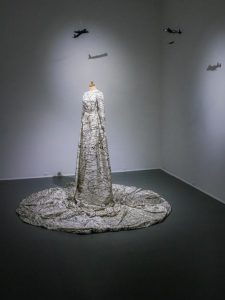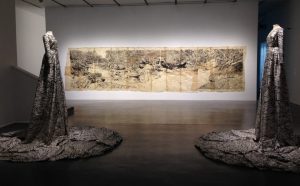Curators' Pick
War Map Dress Trilogy | Carolyn Wren, 2003-2004

Carolyn Wren | War Map Dress Trilogy, 2003-2004
(lino blocks, hand-printed on Dupont silk, thread, zippers, mannequins, model airplanes, black paint)
I encountered these towering figures during Wren’s retrospective exhibition Task At Hand at the now shuttered Rodman Hall Art Centre several years ago. Standing in the large back gallery space, the three female figures dominated the room, with the flow of their dresses spilling out from them, pooling around them on the gallery floor.
Visiting this show numerous times, I found that different ideas came to the fore with different interactions, from initial wonder to later, more critical consideration. When an artist / writer friend, Anna Szaflarski, visiting Niagara, came with me on one occasion, she saw the works in a very different light than I had, initially. Unsurprising, really, as when Szaflarski and I first met, it was around her exhibition at NAC about the historical detritus – or lack thereof – of General Motors’ legacy in St. Catharines, and I believe we connected over an irreverent honesty about history, the region, and the intersecting if conflicting stories of the place we both grew up in….
My reading had been informed by Wren’s own words, which are as follows: The ingenuity of Christopher Clayton Hutton’s invention of silk maps for the British Royal Air Force during World War II enabled pilots to use lightweight and durable maps to help them reach safety in times of crisis, and inspired women to make dresses out of the silk maps as their men returned home. The maps used by Wren in the dresses were made in Europe by the Canadian government and shipped to Canada for families to follow the movements of their loved ones fighting in the war. Alluding to multiple layers of symbolism of the landscape in relation to the body, and reflecting on war and the politics of Feminism (viewpoint, memory, and identity), The War Map Dress Trilogy is more about history, location, distances, than it is about terrain.
I talk a lot about ‘contested narratives’: but this story, this Curator’s Pick is very much about that. Szaflarski – a former student of Wren’s, as Caroline taught in Niagara for some time, and helped shape a few generations of artists and art appreciators – upon seeing the exhibition, and these ‘women’, spoke more in a manner reminiscent of Barbara Kruger’s famous – and still relevant – artwork that declares that YOUR BODY IS A BATTLEGROUND. These battlefield maps, on dresses hanging on mannequins without heads or hands, look more like spaces to be attacked, or acted upon, utterly passive and just victims…. (“Afterwards she could not walk for a week, her feet would not fit into her shoes, they were too swollen. It was the feet they’d do, for a first offence. They used steel cables, frayed at the ends. After that the hands. They didn’t care what they did to your feet and hands, even if it was permanent. Remember, said Aunt Lydia. For our purposes your feet and your hands are not essential.” Margaret Atwood, A Handmaid’s Tale).
More of Carolyn Wren’s work can be seen here. A recent curatorial project of mine, based upon the Rodman Hall Collection, and which included Wren’s work, can be seen here.
Photographs are by Sandy Fairbairn and the author.
~ Bart Gazzola


